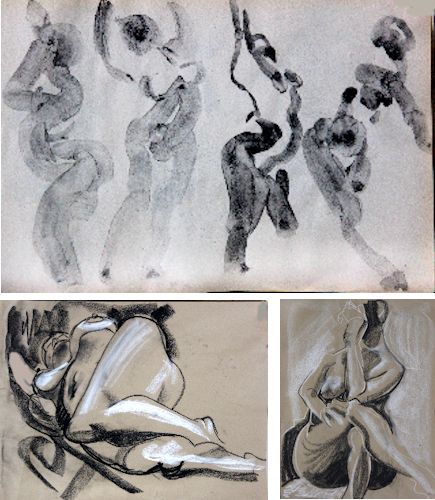
George Romney’s “Learning to Walk” via Wikimedia commons
Typically, a life drawing class will start with a series of gesture drawings as a warm-up. Gesture drawing is good training for artists, especially beginners, and can be done as a warm-up for longer pauses or as a finality in itself. Because you don’t need a model for this exercise, training in gesture drawing can be a great way to people watch. You can go outside and draw people from the patio of a cafe, in a train station, etc. Wherever people move, you can gesture draw!
Here are 6 tips for better gesture drawing work:
1. Follow your intuition
Because all your work occurs in 2 minutes or less, this type of drawing relies on observation and intuition with little to no time for planning or details. You can use the tension and masses of the body to create a sense of movement. The emphasis should be on what the model is actually doing rather than trying to portray a detailed appearance. The more you draw, the more second nature drawing, and your understanding of the human body proportions, will become.

Drawings via Jim Gladden
2. Focus on the movement
The results of gesture drawing are often very expressive, conveying the energy of the pause to give the drawing life. The accuracy of the anatomy might not be perfect, especially for beginners, but the important part is to focus on the movement.3. Let your pencil fly
Because time is of the essence, try to keep the pencil moving at all times. However, this doesn’t mean you should draw with totally erratic lines. You can slow down when needed. Gesture drawing can be done with graphite, pastels, charcoal, watercolor, conté crayon. Drawing fast also means not enough time to erase, so you aren’t limited to a pencil.4. Be attentive
Even though gesture drawing occurs really fast, it is still important to take time to look attentively at the model. Ideally, you should be looking more at the model than at the drawing on the paper. Again, there is not a lot of time for thinking, you really must rely on intuition!
Drawings via Sandrine Pelissier
5. Use the “line of action”
With gesture drawing, you want to convey the essence of the pause. There are various approaches for doing this. One such method is to focus on a “line of action.” A line of action is basically an imaginary line following along the spine or the curve of the arm. Once you have the line of action drawn, you can fill in the three major masses of the body: head, torso and pelvis. Starting with a line of action really helps to visualize the body as lines, shapes and volumes. Drawing via Sandrine Pelissier
Drawing via Sandrine Pelissier

Share tips, start a discussion or ask one of our experts or other students a question.
No Responses to “Gesture Drawing: 6 Tips for Capturing the Art of Motion”